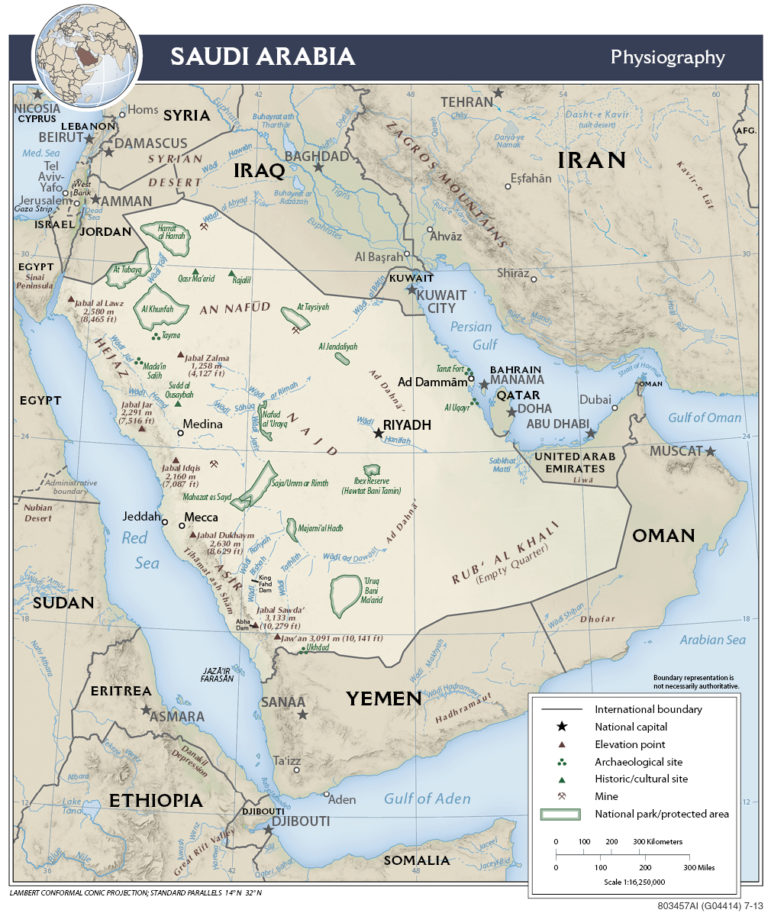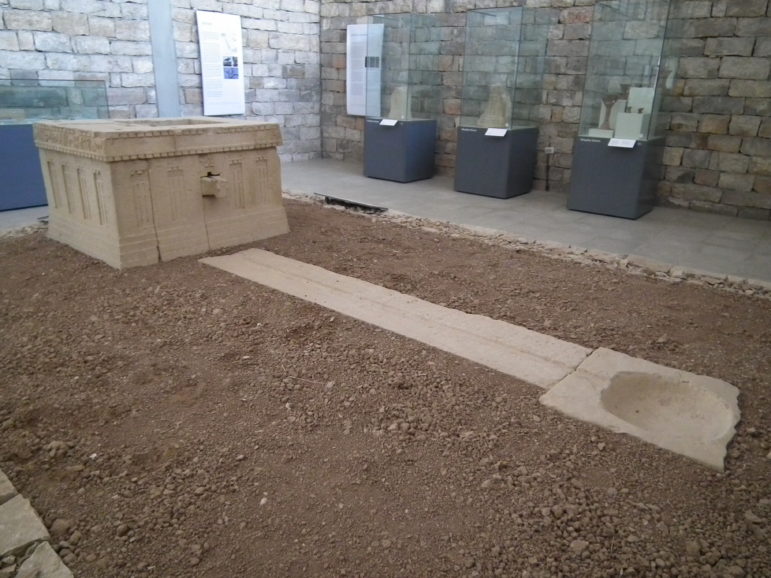TWH – The journal Science reported that a serious drought occurred in Arabia in the 6th Century C.E. which destabilized Arabia. The resulting power vacuum may have opened up space for the spread of Islam in Arabia. Extreme weather, like epidemics, can change history.

Map of the Arabian peninsula – Image credit: Public Domain
The ecology of southern Arabia
The weather of a region co-evolves with its ecology, and disruptions to one will impact the other. Southern Arabia currently has two patterns of rainfall. Mediterranean frontal systems bring rainfall to most of Arabia and northern Oman. Summer monsoons only bring rain to the Yemini highlands and south Oman. The amount of rainfall varies. Current “regional rainfall in southern Arabia varies between 50 and 255 mm year” (2.2 and 10 inches).
The research reported in the journal “Science”
In forested regions, archaeologists can examine tree-ring data to estimate past rainfall. Regions with unstable rainfall like southern Arabia do not lend themselves to tree-ring data.
Instead, scientists on this project examined stalagmite layers in a cave in Oman. Less rainfall will cause less water to drip onto stalagmites. Those years with less rainfall will produce stalagmites with narrower diameters.
A stalagmite that forms on the ceiling of caves is defined as “a deposit of calcium carbonate like an inverted stalactite formed on the floor of a cave by the drip of calcareous water.”
The stalagmites in that Omani cave showed that the severe drought lasted from ~520 to ~532 C.E. Its worst year occurred around ~523 C.E.
To increase confidence in their results, scientists cross-check their results with studies using different methods. The analyzed historical sources and other reports of weather reconstructions. Those sources confirmed an extreme drought occurring around that same time. Data from Turkey showed increased rainfall at that time. That change in rainfall indicates that Mediterranean storms had shifted northward.
The Arabian peninsula before Islam
In the West, the history of Arabia before 600 C.E is often not common knowledge. However, records exist showing 1400 years of history before that point. Complex tribal politics and shifting alliances dominated those 1400 years.
Ancient elites in southwestern Arabia (modern Yemen) grew rich trading frankincense, myrrh, and other aromatics. The ancient world highly valued those aromatics. Southern Arabians also traded spices and condiments from South Asia, as well as ivory and ostrich plumes from east Africa.
A brief introduction to southern Arabian history and culture shows that three southern Arabian tribes grew into proto empires: the Minaeans, the Sabaeans, and the Himyarites. These tribes controlled southern Arabia and its coastal regions from ~800 B.C.E. to 525 C.E.
The Sabaeans lived in southern Arabia. They first appear in Assyrian records sometime between 775 and 625 B.C.E. The Assyrians noted that the Sabaeans had built the Marib dam and other irrigation structures.

Almaqah Temple Libation Altar with drainage channel and basin dating to the 8th Century B.C.E. Currently housed in the Wukro museum in Ethiopia – Image credit: Jessica Strider – CC BY-SA 4.0
The Sabaeans had as their main god, Almaqah, the guardian of irrigation. He was also associated with a bull’s head and vines. In Marib, Almaqah had a temple. It had an elliptical shape. Its major axis had a length of 105.2 meters (345 feet).
Athtar was the god of thunderstorms. Storm gods had special importance in regions with unstable rainfall. For his animal, he had the gazelle.
Originally, the Himyarites were a tribe within the Sabaean Kingdom. Over time, the Himyarites grew more powerful than the Sabaeans. By ~275 C.E, the Himyarites had absorbed the Sabaeans. From 115 B.C.E. to 525 C.E., the Himyarite kingdom ruled much of southern Arabia
Terraced fields and dams channeled water to a land of scarce water. That irrigation system had produced an agricultural surplus. Phys.org quoted Dominik Leetman, the author of the “Science” article. He said that it would take “tens of thousands of well-organized workers” to maintain this system.

Ruins of the temple of Awwam, dedicated to Almaqah in Yemen – Image credit: H. Grobe – CC BY-SA 3.0
That complex system had worked for centuries, but the drought weakened it. The Himyarite Kingdom became increasingly unable to maintain the irrigation system. That system failed between 580 and 600 C.E. The collapse of the Marib dam marked the symbolic end of that system.
Violence, state-to-state, and sectarian
Violence also contributed to ending the Himyarite Kingdom.
North of Arabia, the Eastern Roman Empire, and the Persian Empire had fought each other in wars for centuries, which were interspersed with periods of peace. Both empires were relatively evenly matched, so the front line changed slightly but not by much. Both empires were destroying each other in costly wars.
Of interest to Pagans, the last Pagan Emperor of Rome, Julian (361 to 363) died in one of those wars. He reigned post-Constantine and tried to restore Paganism.
Humans not only have a propensity for state-to-state violence. They also have a propensity for sectarian violence. The Himyarite kingdom, or at least its ruling elite, had converted to Judaism. In 520 C.E., the Himyarite King Dhū Nuwās attacked and began to massacre Christians. The extreme drought began around this time. At present, no one knows if the massacre and the drought are related.
The Christian survivors appealed to their fellow Christian, the Eastern Roman Emperor, who contacted the Christian Kingdom of Aksum (modern Ethiopia). A full-fledged “holy” war ensued. In 525 C.E., Aksum invaded the Himyarite kingdom and proceeded to massacre the Jews. The Aksum army then moved north and tried to besiege Mecca, which failed and is referenced in the Koran.
The Himyarites then appealed to the Persian empire to expel the Aksum army from their lands. The Persians did and the Himyarite Kingdom became part of the Persian Empire.
From 501 to 551 C.E., pilgrimage increased. Those pilgrimages brought more power to central Arabia in general, and Mecca, in particular.
In short, power in the peninsula was shifting towards Mecca. Drought weakened the powers in southern Arabia. The costly wars between the Persian and Eastern Roman Empires had exhausted both empires.
The University of Massachusetts Newsletter quoted professor, Stephen Burns, who worked on this project. Burns said, “We came to realize that climate history is an important factor in the history of human civilization.”
The UMass newsletter quoted Dominick Fleitmann, lead author of the article in “Science.” He said, “When we think of extreme weather events, we often think only of a short period afterwards, limited to a few years.”
The longer extreme weather lasts, the greater the chance for destabilization. The resulting fragmentation could leave people desperate. People could hunger for something or someone to restore order and promote solidarity.
This rise of religion is a complex process with multiple causes. “However,” says Fleitmann, “drought was an important factor in the context of the upheavals in the Arabian world of the sixth century.”
The Wild Hunt is not responsible for links to external content.
To join a conversation on this post:
Visit our The Wild Hunt subreddit! Point your favorite browser to https://www.reddit.com/r/The_Wild_Hunt_News/, then click “JOIN”. Make sure to click the bell, too, to be notified of new articles posted to our subreddit.
